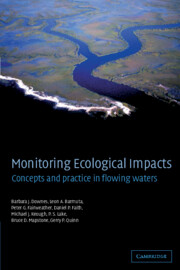Book contents
- Frontmatter
- Contents
- Preface and Acknowledgements
- Part I Introduction to the nature of monitoring problems and to rivers
- 1 Why we need well-designed monitoring programs
- 2 The ecological nature of flowing waters
- 3 Assessment of perturbation
- Part II Principles of inference and design
- Part III Applying principles of inference and design
- References
- Index
2 - The ecological nature of flowing waters
Published online by Cambridge University Press: 21 August 2009
- Frontmatter
- Contents
- Preface and Acknowledgements
- Part I Introduction to the nature of monitoring problems and to rivers
- 1 Why we need well-designed monitoring programs
- 2 The ecological nature of flowing waters
- 3 Assessment of perturbation
- Part II Principles of inference and design
- Part III Applying principles of inference and design
- References
- Index
Summary
In this chapter we provide a very brief introduction to some major concepts in stream or lotic ecology. This chapter is not meant to be comprehensive, but serves to explain some ideas and terms referred to later in this book. Those readers unfamiliar with the basic nature and coverage of stream ecology are recommended to consult the general textbooks of Allan (1995), Giller & Malmqvist (1998) and Boulton & Brock (1999). Readers wanting to gain an understanding of stream hydrology are recommended to consult Gordon et al. (1992).
RIVERS AND THEIR CATCHMENTS
Flowing waters or lotic systems comprise a large array of intergrading types of water channels, be they springs, rills, runnels, becks, burns, brooks, creeks, streams, drains, tributaries, distributaries or floodplain rivers. Even though streams and rivers only make up a small fraction of the surface area in most landscapes, flowing waters are a vital environmental component, even in deserts. Running waters have shaped and continue to shape many landscapes, as they transport water, sediments, chemicals, detritus and biota from headwaters to floodplains and estuaries, and finally to the seas. Rivers supply water to both terrestrial organisms (from trees to humans) and the fully aquatic biota, as well as the biota that inhabits terrestrial systems that are intermittently flooded. Streams in the natural state serve as corridors for the movement of the aquatic biota, and their riparian fringes serve as valuable habitat for, and as potential corridors for movements of, the terrestrial biota.
- Type
- Chapter
- Information
- Monitoring Ecological ImpactsConcepts and Practice in Flowing Waters, pp. 14 - 27Publisher: Cambridge University PressPrint publication year: 2002



